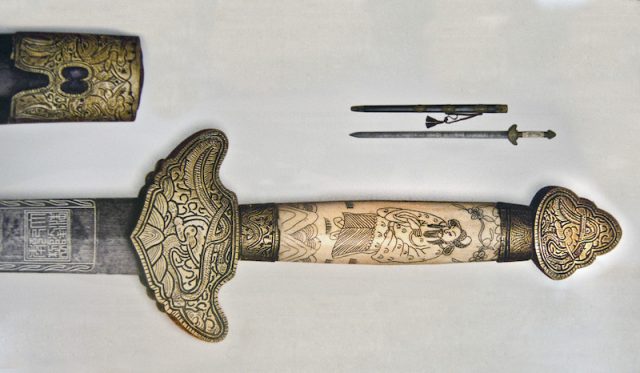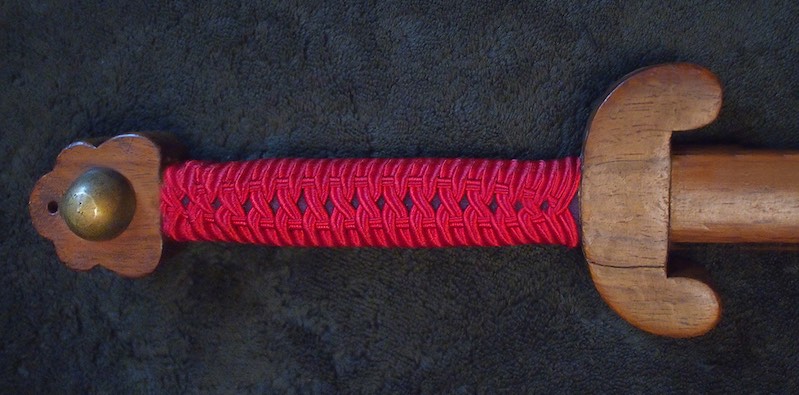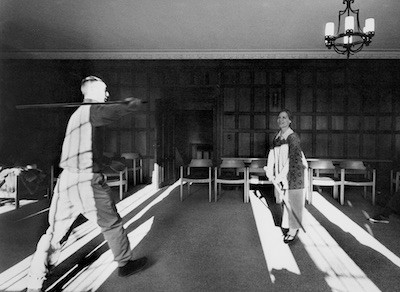THE GRIP
We grip the handle the way a baby holds our finger; the fist is firm, but the arm is relaxed. The flat of our wrist should align with the flat of the blade, which means that the wrist should not be bent. However, this ‘rule’ is broken in three moves in the form. Another reason for the wrist being rarely bent, especially when fencing, is that the guard goes out of line, and the hand becomes exposed.
The transitions to the three whip-like moves “Swallow Beats Water with Wings”, “Awaiting Fish” and “Tiger Wags Tail” require a bent wrist. The three “Swallow Beats Water with Wings” moves will require a slight grip adjustment. These should be performed by allowing the weight of the sword to move with the force of gravity, and not by a radical release and re-grasping. Remember the cliché: If our grip is too tight we lose flexibility and sensitivity, ‘The bird dies’. If our grip is too loose we forfeit connection and we risk being disarmed, ‘The bird flies’.

At first some of the moves will prove difficult and may seem stressful on the joints, potentially causing the grip to lose its integrity whilst trying to get the sword to a correct position. In the early stages of practice it is best to try to keep the grip integrity at the expense of the sword position. Later, as the joints begin to loosen, the sword’s position will improve. Just as tension in any joint will produce a line of tension in all joints, relaxing one joint will tend to relax all the joints. As our right wrist, elbow and shoulder improve their range, so too will the legs and the left side of the body in a crossover response.
Author and Images: Ken van Sickle
German version on our sister site!
Video “THE GRIP – Tai Chi Sword”
- ON BEING A MASTER – Tai Chi Sword 53
- STRANGERS – Tai Chi Sword 52
- PADDED SWORDS – Tai Chi Sword 51
- SAFETY – Tai Chi Sword 50
- PARALLELS – Tai Chi Sword 49
- Swordsmanship – SEVEN QUOTES – Tai Chi Sword 48
- TI FENG & FA JING – Tai Chi Sword 47
- SUPPOSITIONS – Tai Chi Sword 46
- LAO TZU (Laozi) QUOTES – Tai Chi Sword 45
- ETIQUETTE – Tai Chi Sword 44
- FENCING PROCESS – Tai Chi Sword 43
- STRATEGIES – Tai Chi Sword 42
- TASSELS IN THE WIND – Tai Chi Sword 41
- SHOOT FLYING GOOSE – Tai Chi Sword 40
- RHINOCEROS GAZES AT MOON – Tai Chi Sword 39
- THE MASTER SITS BACK – Tai Chi Sword 38
- FIVE APPLICATIONS – 1. BLOCK AND SWEEP – Tai Chi Sword 37
- RULES OF ENGAGEMENT – Tai Chi Sword 36
- CONSIDER – Tai Chi Sword 35
- INVITATIONS – Tai Chi Sword 34
- THE TASSEL – Tai Chi Sword 33
- THE SWORD FINGERS – Tai Chi Sword 32
- Cheng Man Ching Photographs
- THE JOINTS – Tai Chi Sword 31
- THE GRIP – Tai Chi Sword 30
- SWORD MOVEMENT – Tai Chi Sword 29
- ON ALIGNMENT – Tai Chi Sword 28
- CONCERNING THE CENTRE – Tai Chi Sword 27
- EQUATIONS – Tai Chi Sword 26
- HSIN AND CHI – Tai Chi Sword 25
- On studying – NINE QUOTES – Tai Chi Sword 24
- THE SWORD MAIDENS – Tai Chi Sword 23
- THE SWORD AND CALLIGRAPHY – Tai Chi Sword 22
- Returning – MORE THOUGHTS – Tai Chi Sword 21
- Levels of TAI CHI SWORD – Tai Chi Sword 20
- FENCING – Tai Chi Sword 19
- Transcendence – Tai Chi Sword 18
- TURNING TRICKS – Tai Chi Sword 17
- Names of CHENG MAN CH’ING’S TAI CHI SWORD – Tai Chi Sword 16
- FORCE – Tai Chi Sword 15
- DIFFERENCES – Tai Chi Sword 14
- BEGINNERS’ MISTAKES – Tai Chi Sword 13
- MIND SETS – Tai Chi Sword 12
- SENSITIVITY – Tai Chi Sword 11
- HARMONY – Tai Chi Sword 10
- TIME AND HUMOUR – Tai Chi Sword 9
- WHY AND HOW – Tai Chi Sword 8
- SWORD DIMENSIONS – Tai Chi Sword 7
- A ROYALTY OF ARMS – Tai Chi Sword 6
- KENNETH VAN SICKLE – Tai Chi Sword 4
- CHENG MAN CH’ING – Tai Chi Sword 5
- PREFACE – Tai Chi Sword 3
- Introductory Thoughts – Tai Chi Sword 2
- EDITOR’S PREFACE -Tai Chi Sword 1
- Tai Chi Sword by Kenneth van Sickle





